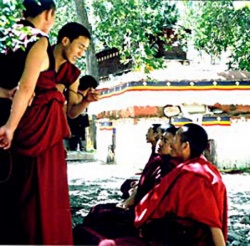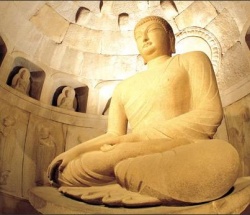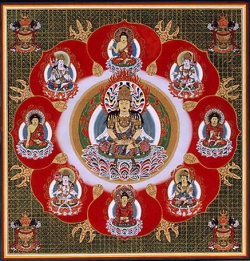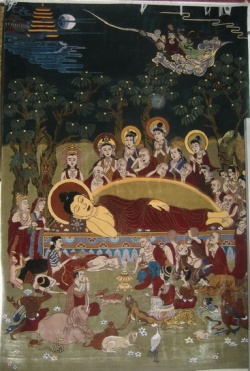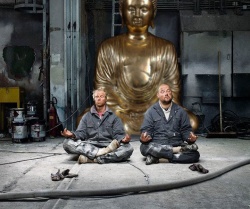Difference between revisions of "Homa"
m (Text replacement - "]]]" to "]])") |
|||
| (4 intermediate revisions by one other user not shown) | |||
| Line 11: | Line 11: | ||
Its practice by "[[Rishis]]" in [[ancient]] time refers close to the {{Wiki|Vedic}} {{Wiki|era}}. At {{Wiki|present}}, the words [[homa]]/[[homam]] and [[havan]] are interchangeable with the [[word]] [[Yajna]] & [[Agnihotra]]. | Its practice by "[[Rishis]]" in [[ancient]] time refers close to the {{Wiki|Vedic}} {{Wiki|era}}. At {{Wiki|present}}, the words [[homa]]/[[homam]] and [[havan]] are interchangeable with the [[word]] [[Yajna]] & [[Agnihotra]]. | ||
| − | [[Homas]] are an important [[religious practice]] in [[Hinduism]] where they are part of most [[Sanskar]] | + | [[Homas]] are an important [[religious practice]] in [[Hinduism]] where they are part of most [[Sanskar ceremonies]]. They are also prevalent in current-day [[Buddhism]] (particularly the [[Tibetan]] and [[Japanese]] [[Vajrayana traditions]]) and [[Jainism]]. |
| Line 19: | Line 19: | ||
| − | [[Consecrated | + | [[Consecrated fire]] |
| − | Although a [[consecrated | + | Although a [[consecrated fire]] is the central [[element]] of every [[homa]] [[ritual]], the procedure and items [[offered]] to the [[fire]] vary by what occasions the {{Wiki|ceremony}}, or by the [[benefit]] expected from the [[ritual]]. Procedures invariably involve - |
| Line 32: | Line 32: | ||
| − | The [[consecrated | + | The [[consecrated fire forms]] the focus of devotions; it is often maintained on specific types of dung, [[wood]], dried coconut (copra) and/or other combustibles. |
| − | While very large [[vedis]] are occasionally built for major public [[homas]], the usual [[altar]] may be as small as 1 x 1 foot square and rarely exceeds 3 x 3 feet square. Again, whereas major [[altars]] at public events may include a hollowing of the [[earth]] to create a relatively deep pit, usual [[altars]] involve no such excavation and indeed rise only inches above the ground. | + | The [[fire-altar]] ([[vedi]] or [[homa]]/[[havan kunda]]) is generally made of brick or stone or a {{Wiki|copper}} vessel, and is almost always built specifically for the occasion, being dismantled immediately afterwards. |
| + | |||
| + | This [[fire-altar]] is invariably built in square shape. | ||
| + | |||
| + | |||
| + | |||
| + | While very large [[vedis]] are occasionally built for major public [[homas]], the usual [[altar]] may be as small as 1 x 1 foot square and rarely exceeds 3 x 3 feet square. | ||
| + | |||
| + | Again, whereas major [[altars]] at public events may include a hollowing of the [[earth]] to create a relatively deep pit, usual [[altars]] involve no such excavation and indeed rise only inches above the ground. | ||
| + | |||
| + | |||
| + | In all events, the arrangement is centered in the middle of a [[space]], which may be either outdoors or indoors. | ||
| + | |||
| + | The [[principal]] [[people]] performing the {{Wiki|ceremony}} and the {{Wiki|priests}} who instruct them through the [[rituals]] seat themselves around the [[altar]], while [[family]], friends and other {{Wiki|devotees}} [[form]] a larger ring around that center. | ||
| + | |||
| + | The length and procedure of a [[homa]] depends on the {{Wiki|purpose}} to which it is performed; many different types of homas [[exist]], and the following list is only illustrative. | ||
| − | |||
| Line 47: | Line 61: | ||
{{Wiki|Ceremony}} Purpose | {{Wiki|Ceremony}} Purpose | ||
| − | |||
| − | |||
| − | |||
| − | {{Wiki| | + | [[Aayushya homa]] to ward off [[evil influences]] {{Wiki|present}} in a child's [[life]] immediately following its [[birth]], thereby ensuring longevity |
| − | [[Chandi]] [[homa]] | + | |
| + | [[Mrutyunjaya homa]])] for ward off life-threatening situations like accidents and ensure longetivity of [[life]] | ||
| + | [[Dhanavantri homa]] for [[good health]] | ||
| + | |||
| + | [[Wiki|Durga homa]] to cancel negative energies; for [[self-confidence]] | ||
| + | |||
| + | [[Chandi homa]] For Victory in all endeavors | ||
| + | |||
| + | [[Gayatri homa]] to facilitate positive [[thinking]] and subsequently performing [[good karma]] | ||
| + | |||
| + | [[Kritya Pariharana]] to counter the effects of [[black magic]] | ||
| + | |||
| + | [[Ganapati homa]] to overcome [[obstacles]] | ||
| + | |||
| + | [[Lakshmi Kubera homa]] for [[wealth]] and material [[prosperity]] | ||
| + | |||
| + | [[Thila homa]] [[homa]] performed for warding of the [[evil]] effects of departed soul.It is performed only once in [[life]] time preferably at [[Rameswaram]]/ [[Thrupullani]]( [[sethu karai]]) | ||
| + | |||
| + | [[Mangala Samskarana homa]] to celebrate [[auspicious]] events; to attain [[Moksha]] | ||
| + | |||
| + | [[Mahadevi homa]] for the [[stimulation]] of a [[marriage]] and for marital [[felicity]] among those already [[married]] | ||
| + | |||
| + | [[Navagraha homa]] to appease the [[Nine planets]] and limit the [[evil influences]] in one's [[horoscope]] | ||
| − | [[ | + | [[Punyahavachana homa]] for the naming of a child |
| − | |||
| − | [[ | + | [[Sudarshana homa]] for [[success]] in an {{Wiki|undertaking}} |
| − | [[ | + | [[Santhana Gopala homa]] for [[blessings]] for a Child |
| − | + | [[Rudra homa]] Getting rid of all negative [[influences]] | |
| − | [[ | + | [[Vastu homa]] a house-warming; to encourage good [[Vastu]] ([[energy]] in buildings) |
| − | |||
| − | [[ | + | [[Vidya homa]] to [[benefit]] students; to facilitate {{Wiki|learning}} |
| − | |||
| − | [[ | + | [[Vishwa Shanthi homa]] for [[universal]] [[peace]] and [[harmony]], as also [[harmony]] between the [[self]] and the [[universe]] |
| − | |||
| − | [[ | + | [[Viraja Homa]] [[purification]] [[rites]] performed as part of the formal {{Wiki|ceremonies}} by which a [[person]] takes the [[vows]] of [[renunciation]] ([[Sannyas]]), thereby becoming a [[Sanyasi]] ([[monk]]) |
| − | [[ | ||
| − | |||
| − | |||
| − | |||
| + | The [[purification rites]] of the [[Viraja homa ritual]] also apply to the formal {{Wiki|ceremonies}} by which a [[Hindu]] [[monk]] takes up the [[vows]] of [[renunciation]] ([[Sannyas]]), thereby becoming a [[Sanyasi]]. | ||
| + | The procedure is a part of the full [[Sannyas Diksha]] [[monastic initiation ceremony]]. | ||
| − | + | After the [[Homa]], the [[monk]] receives the ochre [[robes]] the [[characteristic]] dress of [[Hindu]] [[monks]], from his [[teacher]] ([[guru]]). | |
| Line 92: | Line 119: | ||
[[Shingon]] [[Buddhist monks]] often perform [[homa]] in the morning with [[offerings]] of [[wood]] [[prayers]]. | [[Shingon]] [[Buddhist monks]] often perform [[homa]] in the morning with [[offerings]] of [[wood]] [[prayers]]. | ||
| − | The [[Homa]] ([[護摩]], [[goma]]) [[Ritual | + | The [[Homa]] ([[護摩]], [[goma]]) [[Ritual of consecrated fire]] is unique to [[Vajrayana]] and [[Esoteric Buddhism]] and is perhaps also the most [[mystical]] and cognitively powerful. |
| + | |||
| + | It stems from the {{Wiki|Vedic}} [[Agnihotra Ritual]] and is performed by qualified {{Wiki|priests}} and [[acharyas]] for the [[benefit]] of {{Wiki|individuals}}, the [[state]] or all [[sentient beings]] in general. | ||
| + | |||
| + | The [[consecrated fire]] is believed to have a powerful cleansing effect [[spiritually]] and {{Wiki|psychologically}}. | ||
| + | |||
| + | The central [[deity]] invoked in this [[ritual]] is usually [[Acalanatha]] ([[Fudō Myōō]] [[不動明王]], lit. [[immovable wisdom king]]). Interestingly, the [[word]] [[Acalanatha]] is another [[name]] for [[Shiva]] in the {{Wiki|Vedic}} [[tradition]]. | ||
| + | |||
| + | The [[ritual]] is performed for the {{Wiki|purpose}} of destroying negative energies, | ||
| + | |||
| + | detrimental [[thoughts]] and [[desires]], and for the making of {{Wiki|secular}} requests and [[blessings]]; these are in the [[form]] of pieces of lumber with [[prayers]] written down by {{Wiki|individuals}} and stamped with [[Acalanatha's]] [[seed syllable]]. | ||
| + | |||
| + | |||
| + | In most [[Shingon]] [[temples]], this [[ritual]] is performed daily in the morning or the afternoon, and is a requirement for all [[acharyas]] to learn this [[ritual]] upon entering the priesthood. | ||
| + | |||
| + | Larger scale {{Wiki|ceremonies}} often include the [[constant]] beating of [[taiko]] [[drums]] and {{Wiki|mass}} [[chanting]] of the [[mantra]] of [[Acalanatha]] by {{Wiki|priests}} and lay practitioners. | ||
| + | |||
| + | Flames can sometimes reach a few meters high. The combination of the ritual's visuals and {{Wiki|sounds}} can be trance-inducing and make for a [[profound experience]]. | ||
| + | |||
| − | In | + | In the [[vajrayana buddhism]], [[Fudo Myoo]] is one the [[five Radiant Kings]] or [[Wisdom Kings]]. |
| − | + | But these [[Kings]] or [[Myoo]] are not [[protector]] [[devas]] but [[guardian demons]]. As {{Wiki|Alexandra David-Néel}} explains [[buddhist monks]] are experts in the [[art]] of control {{Wiki|demons}} and reduce them in [[slavery]]. | |
| + | {{E}} | ||
| + | [[Category:Rituals]] | ||
Latest revision as of 00:27, 4 April 2016
Click here to see other articles relating to word Homa
Homa (also known as homam or havan) is a Sanskrit word (Sanskrit: हवन) which refers to any ritual in which making offerings into a consecrated fire is the primary action.
Its practice by "Rishis" in ancient time refers close to the Vedic era. At present, the words homa/homam and havan are interchangeable with the word Yajna & Agnihotra.
Homas are an important religious practice in Hinduism where they are part of most Sanskar ceremonies. They are also prevalent in current-day Buddhism (particularly the Tibetan and Japanese Vajrayana traditions) and Jainism.
Procedure
Homa kunda
Although a consecrated fire is the central element of every homa ritual, the procedure and items offered to the fire vary by what occasions the ceremony, or by the benefit expected from the ritual. Procedures invariably involve -
the kindling and consecration of the sacrificial fire;
the invocation of one or more divinities; and,
the making of offerings (whether real or visualized) to them with the fire as via media, amid the recitation of prescribed prayers and mantras.
The consecrated fire forms the focus of devotions; it is often maintained on specific types of dung, wood, dried coconut (copra) and/or other combustibles.
The fire-altar (vedi or homa/havan kunda) is generally made of brick or stone or a copper vessel, and is almost always built specifically for the occasion, being dismantled immediately afterwards.
This fire-altar is invariably built in square shape.
While very large vedis are occasionally built for major public homas, the usual altar may be as small as 1 x 1 foot square and rarely exceeds 3 x 3 feet square.
Again, whereas major altars at public events may include a hollowing of the earth to create a relatively deep pit, usual altars involve no such excavation and indeed rise only inches above the ground.
In all events, the arrangement is centered in the middle of a space, which may be either outdoors or indoors.
The principal people performing the ceremony and the priests who instruct them through the rituals seat themselves around the altar, while family, friends and other devotees form a larger ring around that center.
The length and procedure of a homa depends on the purpose to which it is performed; many different types of homas exist, and the following list is only illustrative.
Some common Homas
Homa rituals have been performed by Vedic priests for several millennia. The following is an illustrative list of a few such homa rituals:
Ceremony Purpose
Aayushya homa to ward off evil influences present in a child's life immediately following its birth, thereby ensuring longevity
Mrutyunjaya homa)] for ward off life-threatening situations like accidents and ensure longetivity of life Dhanavantri homa for good health
Durga homa to cancel negative energies; for self-confidence
Chandi homa For Victory in all endeavors
Gayatri homa to facilitate positive thinking and subsequently performing good karma
Kritya Pariharana to counter the effects of black magic
Ganapati homa to overcome obstacles
Lakshmi Kubera homa for wealth and material prosperity
Thila homa homa performed for warding of the evil effects of departed soul.It is performed only once in life time preferably at Rameswaram/ Thrupullani( sethu karai)
Mangala Samskarana homa to celebrate auspicious events; to attain Moksha
Mahadevi homa for the stimulation of a marriage and for marital felicity among those already married
Navagraha homa to appease the Nine planets and limit the evil influences in one's horoscope
Punyahavachana homa for the naming of a child
Sudarshana homa for success in an undertaking Santhana Gopala homa for blessings for a Child
Rudra homa Getting rid of all negative influences
Vastu homa a house-warming; to encourage good Vastu (energy in buildings)
Vidya homa to benefit students; to facilitate learning
Vishwa Shanthi homa for universal peace and harmony, as also harmony between the self and the universe
Viraja Homa purification rites performed as part of the formal ceremonies by which a person takes the vows of renunciation (Sannyas), thereby becoming a Sanyasi (monk)
The purification rites of the Viraja homa ritual also apply to the formal ceremonies by which a Hindu monk takes up the vows of renunciation (Sannyas), thereby becoming a Sanyasi.
The procedure is a part of the full Sannyas Diksha monastic initiation ceremony.
After the Homa, the monk receives the ochre robes the characteristic dress of Hindu monks, from his teacher (guru).
In Japanese Esoteric Buddhism
Shingon Buddhist monks often perform homa in the morning with offerings of wood prayers.
The Homa (護摩, goma) Ritual of consecrated fire is unique to Vajrayana and Esoteric Buddhism and is perhaps also the most mystical and cognitively powerful.
It stems from the Vedic Agnihotra Ritual and is performed by qualified priests and acharyas for the benefit of individuals, the state or all sentient beings in general.
The consecrated fire is believed to have a powerful cleansing effect spiritually and psychologically.
The central deity invoked in this ritual is usually Acalanatha (Fudō Myōō 不動明王, lit. immovable wisdom king). Interestingly, the word Acalanatha is another name for Shiva in the Vedic tradition.
The ritual is performed for the purpose of destroying negative energies,
detrimental thoughts and desires, and for the making of secular requests and blessings; these are in the form of pieces of lumber with prayers written down by individuals and stamped with Acalanatha's seed syllable.
In most Shingon temples, this ritual is performed daily in the morning or the afternoon, and is a requirement for all acharyas to learn this ritual upon entering the priesthood.
Larger scale ceremonies often include the constant beating of taiko drums and mass chanting of the mantra of Acalanatha by priests and lay practitioners.
Flames can sometimes reach a few meters high. The combination of the ritual's visuals and sounds can be trance-inducing and make for a profound experience.
In the vajrayana buddhism, Fudo Myoo is one the five Radiant Kings or Wisdom Kings.
But these Kings or Myoo are not protector devas but guardian demons. As Alexandra David-Néel explains buddhist monks are experts in the art of control demons and reduce them in slavery.
